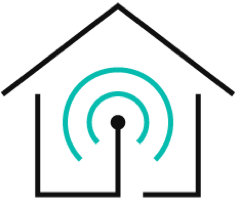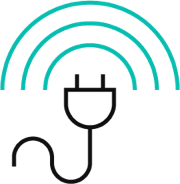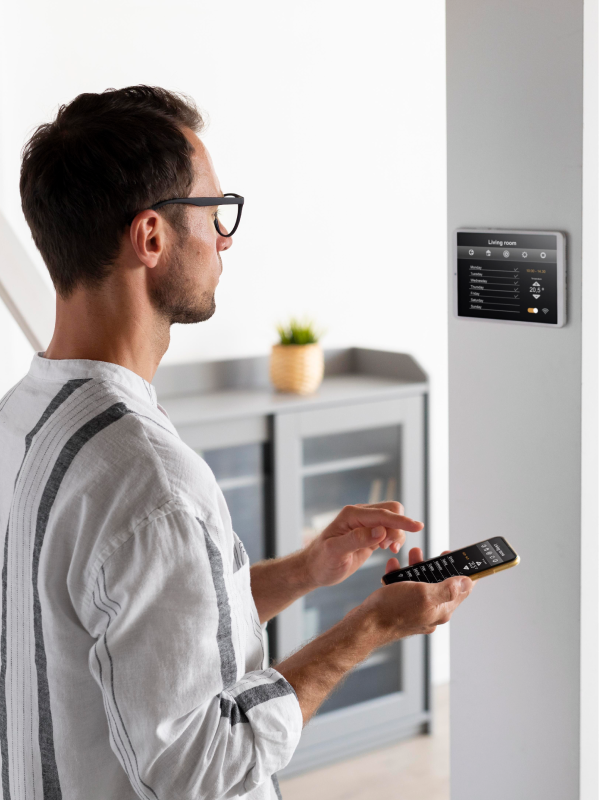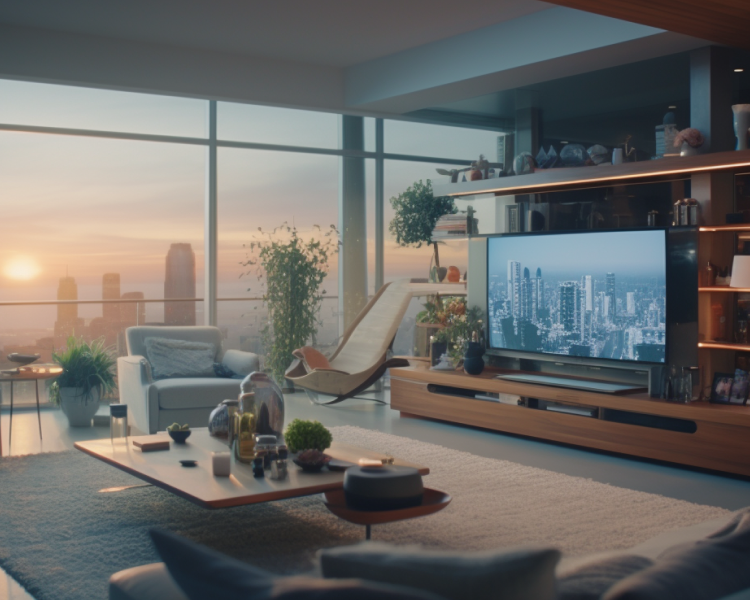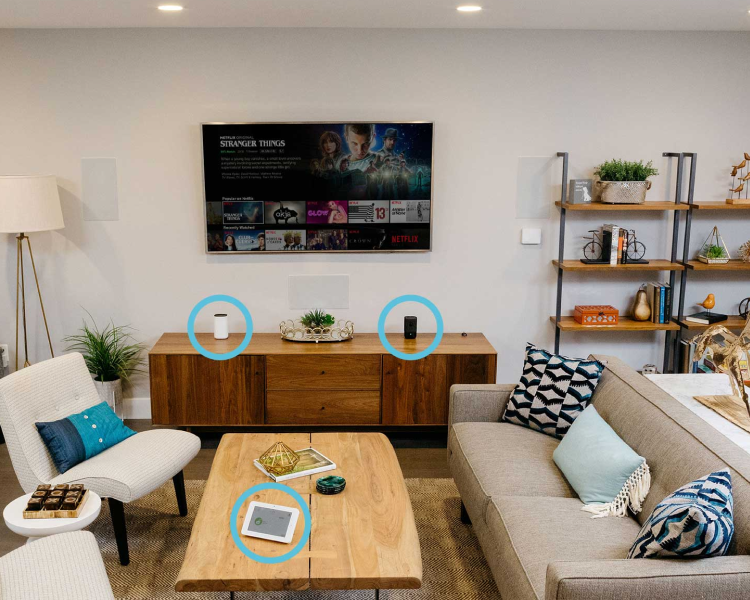Have you ever encountered a scenario where you are at the doorstep of your home on a chilly winter evening, arms full of groceries? If so, did you wish the lights were on and the thermostat was set to cozy warmth?
It would be incredible if your home knew what you needed and responded instantly, right? That is the power of a smart home automation system. However, it will work more efficiently if it is integrated with the most compatible smart home hub.
Today, we will learn everything about a smart home automation system. We will also talk about EVVR and how its technologies can make your home smart and truly intuitive.
- Understanding Integrated Home Systems
- Smart Home Compatibility Challenges
- EVVR Center Lite - User Friendly Hub with High Compatibility
- The Power of Gateway Integration
- The Future of Smart Home Integration
Understanding Integrated Home Systems
When technology prevails, integrated home systems have become the cornerstone in modern times. These systems bring various smart home devices and technologies together to create a seamless and efficient living environment.
So, let’s get to know the components and functionalities of smart home automation systems.
Components of Smart Home Automation Systems
To make a home fully smart and automated, you need to look for the following components. Once you find them, you must integrate them into your home automation system. Here are some of the main components:
- Smart Home Devices: Without smart home devices, we can’t think of integrated home systems. These can include smart thermostats, lighting, security cameras, door locks, and much more. These devices can make everyday tasks more convenient and efficient.
- System Controllers: These controllers act as the brains of an integrated home system. They can be either physical hubs or software-based platforms. These controllers allow you to manage and control all your smart devices from a single interface. Some of the most compatible smart home hubs are Z-Wave compatible hubs and Alexa-compatible hubs.
- Systems Integration: The process that connects and synchronizes all your smart devices and technologies is called systems integration. All the smart components work together harmoniously through this process. Ultimately, this will provide a unified and intelligent home experience.
Functionalities of Integrated Home Systems
Now that you have found the main components of a home automation system, let's take a look at its top functions.
- Remote Control: One of the primary functionalities of integrated home systems is remote control. Using your smartphone or tablet, you can manage your devices even when you are away. Also, you can monitor your home's security.
- Automation: Integrated systems enable automation, allowing your devices to work together based on predefined conditions. For example, you can set your lights to turn on automatically when you arrive home or adjust your thermostat to save energy when you leave.
- Voice Commands: With voice-activated assistants like Alexa, you can control various aspects of your home using simple voice commands. Daily routines become more effortless and hands-free, thanks to this feature.
Benefits of Fully Integrated Setup
You can expect the following benefits if you have implemented an automation system that includes the most compatible smart home hub.
- Energy Efficiency: With smart home integration, you can manage energy in a more intelligent way. You can optimize heating, cooling, and lighting systems to reduce energy consumption. As a result, you will have lower utility bills.
- Enhanced Security: Integrated security systems can provide real-time alerts. Plus, you can monitor your home's security from anywhere. So, you will always have peace of mind.
- Simplicity: A fully integrated setup simplifies your life by centralizing control. You don't need multiple apps or remotes; everything can be managed from one place.
- Customization: You can tailor your integrated home system according to your specific needs and preferences. So, you can create a personalized and comfortable living space.

Smart Home Compatibility Challenges
When you have smart home technology, your house will respond to your every command. It may sound cool at first, but there is a catch: smart home compatibility challenges. These challenges arise from the diversity of smart home devices and their various communication protocols.
Let’s explore these challenges and their impacts on your integrated home system without further ado.

Diversity of Smart Home Devices and Protocols
The smart home market is brimming with thousands of devices. Smart thermostats, smart lights, smart security cameras, and other smart devices are designed to make your life more convenient. The catch is, many of these devices speak different digital languages or protocols. Some of the prominent ones include Z-Wave, Zigbee, Wi-Fi, and Bluetooth. Each protocol is like a unique dialect your smart devices use to communicate.
Compatibility Hurdles
Imagine you have a Z-Wave compatible hub, but your new smart light uses a Wi-Fi protocol. Here lies the challenge – not all devices can easily talk to each other. Without the right system controllers and integrators, your integrated home system may resemble a tower of Babel. Therefore, the devices won't understand each other.
The Impact on Your Smart Home
Smart home device compatibility issues can impact your home in several ways. Below, are some of the severe impacts.
- Limited Functionality: Incompatibility can lead to limited functionality. For instance, you may not be able to control all your devices with a single app or voice assistant.
- Complex Setup: Trying to connect and manage different devices with various protocols can be complex. It may require multiple apps and configurations. Eventually, the situation will become frustrating.
- Added Costs: To bridge compatibility gaps, you might need additional hardware like bridges or hubs. All these will require additional costs.
- Reduced Automation: The dream of seamless automation may not fully materialize if devices can't communicate effectively. This will result in a less streamlined and efficient home.
Solutions to Smart Home Compatibility Challenges
So, how can you tackle these impacts caused by smart home device compatibility issues? To overcome these challenges and enjoy the full benefits of an integrated home system, consider these solutions:
- Choose Compatible Devices: Give priority to smart devices that are compatible with your existing system controllers. In addition, prioritize the most compatible smart home hub you plan to use.
- Research Protocols: You must understand your devices' protocols. At the same time, you must ensure they are compatible with your chosen system.
- System Integrators: It is wise to consult a system integrator or professional to set up and optimize your integrated home system. He will ensure seamless compatibility among all the smart hubs or devices.
- Hub Selection: Invest in a hub or controller that supports multiple protocols. For example, an Alexa-compatible hub can bridge the gap between different devices.
EVVR Center Lite - User-Friendly Hub with High Compatibility
The EVVR Center Lite is a smart hub that serves as the heart of your integrated home system. It is not just any hub but a versatile and powerful solution for your smart home device compatibility needs. You should get EVVR Center Lite today, regardless of whether you are using a Z-Wave or Zigbee protocol.

Features and Benefits EVVR Center Lite
Here are some of the standout features and benefits of the EVVR Center Lite:
- Multi-Protocol Compatibility: EVVR Center Lite supports a wide range of communication protocols, including Zigbee 3.0, Z-Wave Plus, Wi-Fi, or Bluetooth. Moreover, it can integrate with Zigbee 3.0 and Z-Wave Plus devices. This means it can seamlessly connect with a variety of smart devices.
- Simplified Control: With the EVVR Center Lite, you can add more EVVR controllers as connection bridges to form a star network. Say goodbye to the hassle of juggling multiple apps and interfaces. Everything can be managed with centralized control by only one central controller.
- Local Data Storage: The EVVR Center Lite features enterprise-class data encryption. It processes and stores data in local and real-time using a peer-to-peer network connection. There is no data storage in the cloud for enhanced privacy and security.
- Web Console: With EVVR Center Lite, you can create drivers for Zigbee 3.0 or Z-Wave protocol devices or use automatic matching function to connect the devices. This allows you to develop multifunctional plug-ins with the EVVR Console. You can better organize devices and users by configuring and managing home automation. And everything can be done from a user-friendly interface.
- Expandability: As your smart home evolves, the EVVR Center Lite can expand with it. Configure automation for complete integration of smart home accessories on the EVVR App. The EVVR Console includes all the features of the EVVR App. Plus, you can easily add and assign devices to individual rooms for management.
The Power of Gateway Integration
Gateway integration refers to the ability of a central hub or controller to connect and communicate with various smart devices within your home. Think of it as the bridge that brings together different digital languages and ensures that your devices understand each other.
Whether you are dealing with Z-Wave compatible or Z-Wave compatible hubs, an Alexa-compatible hub, or any other protocols, a well-integrated gateway can handle it all. It is like magic behind making your integrated home systems tick seamlessly.

The Benefits of Gateway Integration
- The most significant advantage of gateway integration is ensuring smart home compatibility. With a capable hub, you can add devices of different brands and protocols to your integrated home system. And you don’t have to worry about whether they will work together or not.
- Instead of juggling multiple apps or interfaces, gateway integration provides you with a single, user-friendly control point. This simplifies the management of your smart devices. Therefore, you can easily control lights, thermostats, security systems, and more from one place.
- Gateway integration enables robust automation capabilities. You can create custom routines and rules that trigger actions across various devices. For example, when your smart door lock is unlocked, the lights can automatically turn on and the thermostat can adjust to your preferred temperature – all through seamless integration.
- Many gateways are compatible with popular voice assistants like Alexa and Google Assistant. As a result, you can control your smart home devices with simple voice commands. So, you can create and organize daily routines conveniently.
- You can keep your integrated home system future-proof through gateway integration. Due to its excellent scalability, a well-integrated gateway can expand with it. You can add new devices without worrying about compatibility issues.
The Future of Smart Home Integration
Smart homes have come a long way, evolving from standalone gadgets to interconnected ecosystems. When we look to the future, it is clear that smart home integration will only become more powerful and prevalent. So, we need to know what lies ahead for integrated home systems.
Seamless Systems Integration
The future of smart home integration promises even more seamless system integration. We are moving toward a period where devices from different manufacturers will effortlessly communicate with each other. Whether it is a Z-Wave-compatible hub, an Alexa-compatible hub, or any other protocol, compatibility barriers are shrinking. All in all, it is becoming easier to create a cohesive and interconnected smart home.
AI and Machine Learning
Artificial Intelligence (AI) and machine learning will determine the future of integrated home systems. These technologies will enable a smart home to learn the preferences of the homeowner. They will adapt to the lifestyle of the homeowner accordingly. Imagine your home knowing when to adjust the lighting, heating, and security systems without you having to lift a finger.
Voice Control Evolution
This feature is already a staple in many smart homes and will continue to evolve. Future integrated home systems will have more advanced ways to understand natural language. This will make voice commands even more intuitive. Your smart home will become a conversational partner, understanding context and complex requests.
Energy Efficiency
As sustainability becomes a growing concern, integrated home systems will focus on energy efficiency. Smart homes of the future will be highly optimized. They will automatically adjust energy consumption based on factors like occupancy and weather conditions. This not only reduces the environmental impact but also lowers utility bills.
Enhanced Security
Security is a prime concern, and future integrated home systems will prioritize it. In the future, we can expect more robust security measures in smart home automation systems. These include biometric authentication, advanced encryption, and AI-driven threat detection. A smart home will keep its residents comfortable and safe.
Interconnectivity Beyond the Home
The future of smart home integration extends beyond your four walls. Your integrated home system will connect with your car, wearable devices, and other aspects without any interruptions. Automation systems will likely transition from home to car to office.
Customization and Personalization
In the future, we can only predict that integrated home systems will become even more customizable and personalized. Your home will be able to tailor automation routines and settings to your exact preferences. Ultimately, your smart home will truly become extraordinary.
Conclusion
A smart home automation system can potentially transform how we live. Integrating with the right smart home hub can make our homes more intuitive and convenient. It enhances our lives in countless ways.
Hopefully, you have found almost everything you need to know about a smart home automation system. Also, you should be able to identify the most compatible hubs by now. So, integrate those tiny devices into your smart home automation system if you haven’t yet. And feel free to contact us if you still have any queries about the smart home automation system. We will get back to you as soon as possible.

